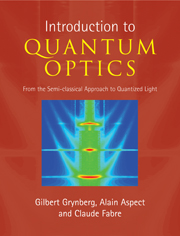Book contents
- Frontmatter
- Contents
- Foreword
- Preface
- Acknowledgements
- Part I Semi-classical description of matterlight interaction
- Part II Quantum description of light and its interaction with matter
- Part III Applying both approaches
- 7 Nonlinear optics. From the semi-classical approach to quantum effects
- Complement 7A: Parametric amplification and oscillation. Semi-classical and quantum properties
- Complement 7B: Nonlinear optics in optical Kerr media
- 8 Laser manipulation of atoms. From incoherent atom optics to atom lasers
- Complement 8A: Cooling to sub-recoil temperatures by velocity-selective coherent population trapping
- Index
Complement 8A: Cooling to sub-recoil temperatures by velocity-selective coherent population trapping
Published online by Cambridge University Press: 05 August 2012
- Frontmatter
- Contents
- Foreword
- Preface
- Acknowledgements
- Part I Semi-classical description of matterlight interaction
- Part II Quantum description of light and its interaction with matter
- Part III Applying both approaches
- 7 Nonlinear optics. From the semi-classical approach to quantum effects
- Complement 7A: Parametric amplification and oscillation. Semi-classical and quantum properties
- Complement 7B: Nonlinear optics in optical Kerr media
- 8 Laser manipulation of atoms. From incoherent atom optics to atom lasers
- Complement 8A: Cooling to sub-recoil temperatures by velocity-selective coherent population trapping
- Index
Summary
In Section 8.3.9, we mentioned that the recoil temperature was not the ultimate barrier to cooling. Several mechanisms have been conceived and implemented to concentrate the atomic velocity distribution in a range of values of width less than VR. In contrast to Doppler or Sisyphus cooling, these mechanisms do not appeal to a friction force, but rather to an optical pumping process (see Complement 2B), able to accumulate the atoms in this narrow range of velocities. We now present one such mechanism called ‘velocity-selective coherent population trapping’, considering only the case where the motion occurs in one space direction (the Oz-axis). Note, however, that the method generalizes to two or three dimensions.
Coherent population trapping
Coherent population trapping is a phenomenon that occurs when an atom has a system of three energy levels in the ∧ configuration shown in Figure 8A.1, where each leg of the ∧ interacts with a laser L− or L+. This was discussed in detail in Section 2D.2 of Complement 2D. Here we consider the case where the two ground states g+ and L−, have exactly the same energy, and the two lasers have frequencies ω+ and ω−, very close to the resonance frequency ω0. In this situation, the selectivity of the interactions is obtained via the polarization selection rules (see Complement 2B): if g−, g+ and e have magnetic quantum numbers m = −1, +1 and 0, respectively, the laser wave L− is right-circularly polarized (σ+ polarization), while the laser wave L+ is left-circularly polarized (σ− polarization).
- Type
- Chapter
- Information
- Introduction to Quantum OpticsFrom the Semi-classical Approach to Quantized Light, pp. 651 - 660Publisher: Cambridge University PressPrint publication year: 2010



